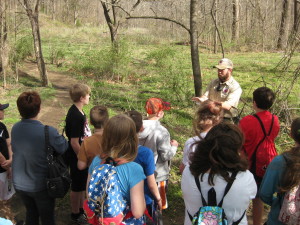 On April 4-5, more than 200 sixth graders from Read Mountain Middle School and Central Academy Middle School visited Roanoke Cement’s farm on Catawba Creek as part of a Meaningful Watershed Educational Experience (MWEE) organized by Mountain Castles Soil and Water Conservation District and Roanoke Cement.
On April 4-5, more than 200 sixth graders from Read Mountain Middle School and Central Academy Middle School visited Roanoke Cement’s farm on Catawba Creek as part of a Meaningful Watershed Educational Experience (MWEE) organized by Mountain Castles Soil and Water Conservation District and Roanoke Cement.
Aquatic macroinvertebrate sampling was one highlight of the day. Students used a kick net to collect hellgrammites, crayfish, mayflies, water pennies, and other bottom-dwelling creatures. Back in class, they will use their data to calculate a water quality value for the creek.
Students also identified wildlife sign, pulled garlic mustard — an invasive plant species — and learned how healthy soil and forests impact water quality.
The field experience is part of a larger watershed unit which included classroom activities and a student-initiated conservation project at each middle school.
“We want to help students understand that learning can happen anywhere – especially outside,” says Tim Miller, the education and outreach coordinator for Mountain Castles SWCD. “We also want to help teachers integrate outdoor experiences in the school curriculum.” Miller strongly feels that appreciation for natural spaces is an essential part of conservation education. “Once students experience the creek first-hand, they care about water quality and are much more likely to actively protect it,” Miller says.
The MWEE “dream team” included local representatives from Virginia Cooperative Extension, Farm Service Agency, Natural Resources Conservation Service, Virginia Department of Forestry, Virginia Department of Environmental Quality, Appalachian Trail Conservancy, and Roanoke Cement.
The Catawba Creek MWEE is supported through funding from the Chesapeake Bay Restoration Fund (which comes from sale of the Chesapeake Bay license plate), Roanoke Cement, and Mountain Castles SWCD. Funding has already been secured for the 2017-2018 events, with plans to “pilot” an experience for students at Lord Botetourt High School, too.
